Brian Nelson: A Life of Racing
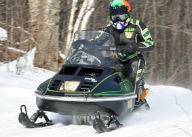
This Hall of Fame cross-country ace still wants to win
“I want to win just as bad today as I did when I was 20 years old,” stated 57-year-old Brian Nelson, who is a two-time I-500 winner, legendary cross country racer, and Hall of Fame inductee. After a 15-year racing hiatus, Nelson has returned to his roots of cross-country racing. In fact, he is racing the Arctic Cat Cross Country Cat that brought him multiple race wins and his second I-500 victory. This past January the Spicer, Minnesota native competed in the vintage class of the USCC Red Lake I-500 and captured second place.
Few have had such a storied, distinguished and diverse career in the snowmobile industry. Nelson possesses a special blend of racing talent, mechanical skill, engineering acumen and business sense. He has been a professional snowmobile racer, an engineer and designer, an owner and operator of a flourishing snowmobile dealership, and now runs a successful tour business. But what has set Nelson apart from many other racers is his ability to create an innovative design, recognize the potential of a snowmobile component and optimize a setup.
The Minnesota native started out his snowmobile industry career as a professional racer and had his big breakthrough driving the John Deere Liquidator to win the 1976 I-500. The next year, Nelson moved over to the Arctic Cat cross-country race team, but the sled’s suspension system certainly wasn’t cutting edge and there was a lot of room for improvement. Nelson, along with his mechanic/engineer partner Hubert Fixsen, designed and developed an innovative front and rear suspension system for the 1978 Cross County Cat. The leaf spring was a common setup for the era, but the Arctic Cat team took it a step further, developing a pivoting shackle design that provided far greater ride and control.
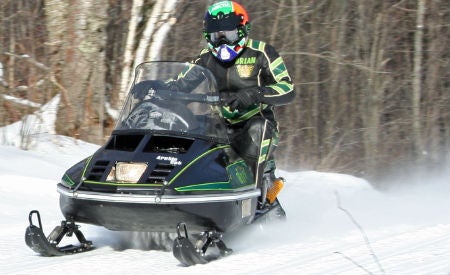 Wearing his vintage Team Arctic leathers, Brian Nelson is shown at speed on the 1979 Cross Country Cat.
Wearing his vintage Team Arctic leathers, Brian Nelson is shown at speed on the 1979 Cross Country Cat.In the early 1990s, Nelson and Fixsen teamed up again with the engineering brain trust at Arctic Cat to develop the first ZR440 cross-country racer, which was released in 1993. From 1990-1997, he fielded a cross-country race team, which included racers Jeremy Fyle, Dan Skallet, John Sandberg and others. He also owned and operated Nelson Marine, an Arctic Cat and Polaris dealership in Spicer, MN, from 1979-1997. But at his core, Nelson has a passion to compete — not only racing sleds and winning races, but also building and engineering race sleds.
Tour Business and Dealership
Nelson has owned and operated Nelson Tours for 32 years. As the demand for winter tours slowly dwindled over the years, Nelson shifted his business to focus on motorcycle and ATV tours. He said, “This summer we are doing an ATV tour to Wind River Ranch. And we do four or five trips every year for the Harley dealers. Spring and fall is when we do the bike trips.”
In addition, Nelson owned Nelson Marine in Spicer, Minnesota for 18 years. But in early January 1998, Nelson received an attractive offer to sell his dealership and he took it. During his last year running the dealership, nearly 1,000 sleds were sold. He said, “I sold 500 new and 490 used [sleds] in 1997. We did $8 million in business that last year that we were there.” Currently, Nelson is an insurance broker and runs his tour business.
An Irresistible Pull of Competition
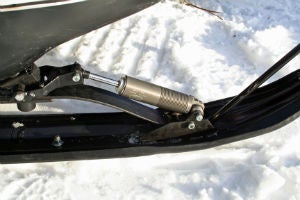 The shackle leaf spring front suspension that pivots to better utilize the ACT high-pressure gas shock.
The shackle leaf spring front suspension that pivots to better utilize the ACT high-pressure gas shock.When many racers his age have hung up their helmet and gone fishing, Nelson’s competitive spirit and determination to race at his personal best has not dimmed. Racing is a microcosm of life with all the boring parts left out, and in cross country racing it’s a test of your mettle, your physical strength, your mental strength, and how well you stack up against the competition. And this challenge resonates with Nelson.
The die-hard Arctic Car rider still pounds through the holes in ditch lines and attacks drifts with a tenacity of someone far younger.
His first I-500 was 35 years ago, but for this gentleman racer the fierce passion for racing keeps burning. He embraces the methodical sled preparation, the physical training, and testing to get ready for the grueling punishment of cross-country racing.
The path back to racing started about 11 years ago when Nelson was inducted into the Snowmobile Racing Hall of Fame. As he explains, “About three or four years ago, Jon Carlson [former cross country snowmobile racer], who’s on the board of the [Snowmobile Racing] Hall of Fame, got this idea of promoting a vintage ride for the Hall of Fame induction ceremony. Some guys from New York and Indiana built me a vintage sled to ride. I rode it and it was a lot of fun, and there were all these other old racers there. Everybody got the idea that we should have a race. Jon was the big proponent of it. So I mentioned to him [Carlson] that they do the I-500 anyway, I’d talk to Pat [Mach, owner of USCC] about it [a vintage race]. We promoted it to him and he [Mach] was quick to think that that would be good for his race. It kind of took off from there.”
With the support of Mach and the USCC, Nelson jumped into the vintage challenge with both feet. Nelson diligently searched the Internet, local snowmobile salvage yards and other sources for the leaf spring sled that had carried him to victory so many years ago — the Cross Country Cat. Nelson eventually came up with eight Cross Country Cats. Interestingly, he acquired one sled from a local junkyard, and after looking it over it seemed very familiar. After discovering a few of his telltale modifications that he had made back in the late 1970s, he realized he had just found one of his old race sleds. From all the sleds he had acquired, Nelson would have several race and practice sleds as well as many spare parts.
Buying and Rebuilding Cross Country Cats
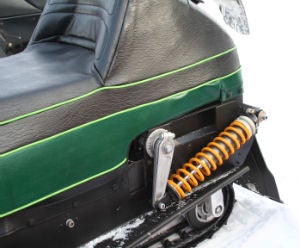 The Cross Country Cat’s rear suspension features outboard mounted shocks and delivers about 7 inches of travel.
The Cross Country Cat’s rear suspension features outboard mounted shocks and delivers about 7 inches of travel.Buying all this vintage iron was just the first step to get back to the track. He had a lot of work ahead of him to build these sleds into race-ready vehicles. For about eight months, he spent almost every night after work in his home workshop, building, working and tweaking the cross country Cats. In fact, Nelson estimates that he has over 800 hours into building all the Country Cats that he prepared for this year’s I-500 race. During that time, he built three ready-ready sleds, one for himself—one for Arctic Cat Snowmobile Product Manager Joey Hallstrom, and one for Pride Editor and former pro racer John Sandberg.
He said, “We just started with a tunnel and bulkhead and just sandblasted them and started rebuilding. There was no advantage to buy a real nice sled that was all fixed up and painted up. It didn’t bother me to start with a pile of ‘scrap iron’ because we were going to rebuild the whole thing anyway. The tunnels and the bulkheads were all pretty good. There were some tweaks and dents, and dings and that you could pound out. But we found the suspension components, like the front arms, the weldments, virtually every one of those was bad, cracked, broke, and tweaked and bent. They were in the junkyard for a reason.”
The core of the Cross Country Cats, meaning engine, tunnel, bulkhead, and skid frame, remained the same, so these components are circa 1979. But that’s where much similarity to the original sleds end because the running gear is modern equipment. Hence, these Cross Country Cats accelerate and brake far better, handling and ride is much improved, and overall these sleds are much more efficient than the sleds Nelson raced back in the 1970s. Over the last 30 plus years, the available technology has transformed the snowmobile industry, and it’s now available to make the Cross Country Cats far better than they ever were before.
Starting at the front, the engine is a 340 liquid-cooled Suzuki twin, but it uses the Comet-type Arctic Cat six post drive clutch and ZR roller driven secondary clutch. The chaincases, jackshaft, and related parts are all from the mid-1990s Arctic Cat ZR. When the sleds were manufactured in the late 1970s, these were equipped with a 2-inch pitch Rockland track. A 2.52 external drive sprocket limited the aftermarket track options for these Cats, and the suspension is not compatible with an internal drive design. As a result, the tracks are not a modern Camoplast Ripsaw, Cobra or similar design. Two of the sleds have 121-inch long track while the third has 116-inch long track with a sport design lug. According to Nelson, “the 121-inch tracks had a fairly high durometer [rubber] and fairly straight bar. They were fairly fast in soft snow but not that good on ice. Each one had its good and bad points.”
Suspension was another area in which significant improvements were made. Up front, the leaf spring suspension is not a common late-1970s, early-1980s set-up. Instead, it features a pivoting shackle leaf spring shock arrangement, which was a special cross country kit upgrade back in the day. This pivoting shackle design transfers more of the force of the bump into the shock rather than the leaf spring for a far better ride. Essentially, the leaf spring slides forward and leverages the shock more than a common leaf spring design. To utilize modern suspension technology, Fox-type ACT aluminum-body internal floating piston gas shocks are fitted to the skis. Nelson explains, “It’s particularly important to absorb as much of that [impact of the bumps] with the shock absorber. What that [shackle] system enabled us to do is get more shock travel, and absorb more of that energy before you bottomed out. It worked good in ’78 and ’79. Those spring kits were just a kit, and they were never produced for a production sled. And they’re hard to find now. I found two sets and they’re hard to duplicate. It would be very expensive to tool up to make new springs. We ran the stock steel skis and we ran the ski skins on the bottom.
The tunnel houses an early version of extended travel suspension. To get the best performance in cross country race conditions, the shocks were moved from the center of the skid frame to outside of the tunnel. A linkage from the rear idler shaft connected to the tunnel mounted shocks. A stock El Tigre at the time had about an inch of shock travel and 3 to 4 inches of rear suspension travel, and it was digressive or falling rate with most amount of shock travel in the initial part of the stroke and the least at the end. For cross-country racing, a progressive rate provides the best damping characteristics. With outboard mounted shocks and revised suspension geometry, shock travel increased to 4-1/2 inches and suspension travel improved to seven inches. Fox IFP shocks, fitted to the rear linkage, provide superior performance over the old hydraulic shocks. Also the skid was lightened because the heavier steel swing arms and parts were eliminated. According to Nelson, “It [the suspension] was a little over a 2:1 ratio and its linear shocks travel at the same rate as the suspension speed. It’s a lot easier to valve it and the shocks are dissipating the energy.”
Other key improvements included modern progressive seat foam for increased comfort and ride quality. The original 6.7-gallon gas tanks were not quite big enough for a 170-mile race, so the Cats were fitted with modified 8-gallon tanks from the Arctic Cat Cougar.
Sampling the Cross Country Cat
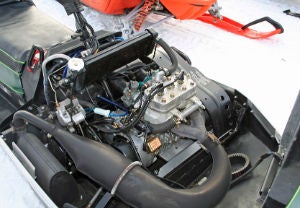 Under the hood, you see the modern ZR chaincase and Wilwood hydraulic brake among other tweaks.
Under the hood, you see the modern ZR chaincase and Wilwood hydraulic brake among other tweaks.I had a special opportunity to ride the 1979 Cross Country Cat that Brian Nelson built for practice and for Joey Hallstrom to race. In fact, this was the sled that would win the I-500 vintage class. I have owned and ridden a slew of vintage sleds over the years, but it had been a while since I had trail ridden anything from that era. Initially when I climbed aboard, I felt like I was transported back to 1979 and it felt a lot like a Pantera I used to ride, but all the new components and parts transformed the sled’s performance. The sled sits far lower than a modern IFS/ long travel sled, but the Cat had a far lower center of gravity, so the sled felt very light because it’s far lighter than a modern sled. The steering was very responsive and it cornered very flat. Immediately, I was impressed with acceleration of the sled. From the bottom end to mid range the sled pulled very strongly and I had no problem keeping up to other aggressive riders in our group. When I encountered bumps, I was expecting the front end to respond like a traditional leaf spring suspension, popping off the top of the bumps. Again, I was amazed, the shackle system absorbed the impact of the bumps and remained flat over the bumps.
The Wilwood brake hauled the sled down from speed with the touch of a single finger. The backshift was right there when letting off the gas so you could power out of the corners. The rear suspension was also far better than any production sled I have ridden from the late 1970s or early 1980s. After my trail ride, I was convinced I could keep up with most of the people I ride with on the trail. This sled was definitely dialed in and flying.
These modernized Cross Country Cats are far faster than the original versions of the sleds. To put it into perspective, Nelson said, “You’d have a good 5-8 mph top end, and of course, you’d have a big gain on acceleration because the clutching was so much more efficient.” He went on to say, “you could probably put myself or Kirk Hibbert [another cross country racing legend] on one of these ’79s, and you could put an average rider and put on these new ones. And I couldn’t beat the new sled.”
To Race the I-500
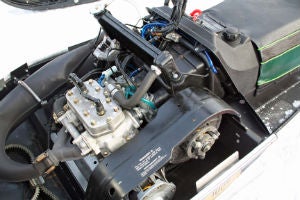 The Comet-type Arctic drive clutch and roller driven clutch deliver far better performance than original equipment.
The Comet-type Arctic drive clutch and roller driven clutch deliver far better performance than original equipment.To prepare for the I-500 is no small endeavor, whether it’s training or building a sled. And Nelson has a lot of mileage on his body. He said, “To get a 57-year-old body ready, especially one that has hundreds of thousands of snowmobile miles on it, my back, my shoulders, and joints are pretty well used up. I have a new left knee and they say I need new shoulders. I worked out pretty hard, but the problem I had prior to the race, the harder I worked out the sorer I got. It was really tough to prepare physically as hard as I wanted to. Every time I went out for a snowmobile ride I was probably so sore I couldn’t ride again for four or five days.” To cope with pounding of the actual event, Nelson had to use some modern pharmaceuticals to get ready for the event. “I was able to put cortisone in my knuckles in my left hand and in my right shoulder and that settled that down,” he added.
The actual I-500 was a very physically challenging race because the vintage sleds ran after the other sleds had raced over the course. As Nelson puts it, “After the big sleds go through, it’s going to be like a 180-mile snocross.” Actually, the Vintage Legends class would race 170 miles on the Saturday leg of the I-500.
Nelson ran fast and consistently throughout the race. Teammate Hallstrom eventually passed him and so did Arctic Cat mounted Aaron Scheele, but Scheele’s engine eventually seized and he DNFd. While Nelson attacked the course, he couldn’t make up the time to Hallstrom. The bumps and drifts eventually took their toll on him. “I felt pretty good to the first gas stop, but then when we headed out of the first gas stop,” he recalled. “Over these finger drifts outside of Warren [Minnesota], 140 sleds that were ahead of us. You could hardly see a track [had run over the drifts]. These drifts were just like a boulder field. I used to love that when I was young because I could take the beating. But now, the back of the sled is slapping you in the butt about 40 times a minute. When you’re trying to go through there at 50 to 60 miles per hour, after a while my back wouldn’t take it anymore, and the pain got so bad I just had to back out of it. Joey [Hallstrom] caught me and drove by.” Hallstrom took the checkered flag and victory with a time of 3:51:18, and Nelson followed in second about 5 minutes behind, with a time of 3:56.
Reflecting on the race, Nelson said, “We ran fast, we did our homework and ran a good race. It was disheartening in a way to take second, but I am proud of Joey [Hallstrom] for the job he did. John Sandberg, the crank bearings went out on that sled too the same as Aaron Scheele’s. John is smart rider and a hard rider, so I am guessing he would have been in there too.”
But once again, Nelson is looking ahead to the next challenge and the next year’s I-500. “I know there’s a lot of things I can do for next year. We definitely plan on going back and we will be faster. I have two and half pages of notes for things to improve on the machines.”
The drive to compete still burns bright and the quest for more speed never ends.








 Your Privacy Choices
Your Privacy Choices